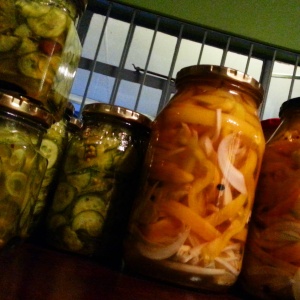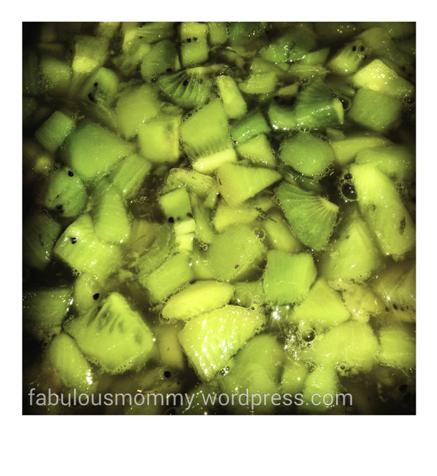Of all the info about me in my Twitter and Instagram profiles, the thing that gets the most interest is the fact that I brew my own kombucha.
My love affair with kombucha goes way back to when I was small and living with my grandmother. I remember her brewing all sorts of odd things on top of the cupboards in the kitchen including a very potent alcoholic ginger beer. Now you may be rolling your eyes and thinking “ah she comes from a long line of hippies” but you couldn’t be more mistaken. My granny was an old-school, British school ma’am. She was a teacher and at one of the schools she taught at the kids had, not so subtly, given her the nickname “The Dragon”.
To me though she was just my granny, and also one of the most magical people I know. My love of cooking was nurtured in her kitchen from the time I could barely reach the stove top while standing on a chair. She let me make scrambled eggs and help with food prep. We would also bake together, filling endless tins with a variety of cookies. My favourite were the ones with raisins in them that had been rolled in cornflakes, and jam tarts filled with apricot jam. I would bite the jam tarts open and then dip them in my tea, the tea would melt the jam and I would drink the sugary concoction out with the unadulterated glee that only a 5 year old can possess, hoping that I could eat the tart before the whole mess fell apart in my hand.
Now as an adult, going back into those memories of childhood, I remember my granny having a bucket with a weird rubber thing in it that she made a weird fizzy drink with. A couple months ago it hit me with lightning clarity that it had been kombucha that she had been brewing.
I wish I could have asked her about it. Sadly she passed away and with her went a lifetime of knowledge. The loss of her still catches me unawares in moments like this, wanting to ask her about her kombucha instead of finding all the info online.
So, nostalgia aside, what the is kombucha?
Kombucha is a fermented tea. It can be made with any assortment of teas and herbal infusions. I have even had coffee kombucha which blew my mind and left my taste buds tingling with delight. My own preference is for rooibos (red tea) kombucha but you can make it from black teas like a nice smoky oolong, green teas, your stock standard Ceylon tea, or even an herbal infusion like mint or Echinacea.
All you need to get started is a SCOBY.
What the hell is a SCOBY?
SCOBY is an acronym for a symbiotic culture of bacteria and yeast. Basically it is a rubbery white to cream coloured fungus-like thing. Sounds grand doesn’t it? Don’t worry it is really rather innocuous and not at all gross.
Where to get a scoby:
If you live in the USA you’re in luck because you can buy a scoby easily online.
Here in the RSA though it is a bit more challenging. I got mine from a farmers market in Pretoria. Any foodie worth their salt will know of The Boeremark in Silverton. There is a woman there who sells scobys and kefir granules. Otherwise, find a friend who brews kombucha and beg a scoby off of them, with each brew cycle your mother scoby forms a new child scoby and thus you will eventually be inundated with the things. It is apparently also possible to grow a scoby from unpasteurised kombucha but this has varying success rates, we might be a bit more successful with this in SA as we don’t have the same food regulations as the USA and our commercial kombuchas are still alive.
What you need to make kombucha:
A fairly large (preferably glass) container
A scoby
3L of tea
2 cups of sugar
Half a cup of organic, unfiltered apple cider vinegar or 1 cup of your previous batch of kombucha
How to:
Thoroughly clean your glassware and anything else which will come into contact with your tea. You can use a mild solution of Milton’s and water, just make sure to leave everything to properly dry afterwards. I use hot soapy water and then rinse everything with apple cider vinegar as the acidity of the vinegar kills most nasties that could contaminate your kombucha. UNDER NO CIRCUMSTANCES SHOULD YOU EVER USE ANTIBACTERIAL SOAP, it will kill your scoby!
You can wash your hands well with a mild soap and then rinse with apple cider vinegar too. Just remember that the vinegar can be quite corrosive and if in doubt rather buy a box of non-latex gloves for food prep.
Boil water in a large, non reactive pot for 5min, allow to cool to 70’C, add the tea, allow it to steep for 5 min (or longer if you like a stronger tea), add sugar and then let the whole lot cool to room temperature.
Add your tea, and cup of kombucha or vinegar to your glassware and then gently try floating your scoby on top. Some scobys float, some sink, don’t worry too much as a new scoby will form on the top of your liquid but ideally you want your scoby to float as it protects your kombucha from nasties like aspergillus. The kombucha or vinegar makes the tea acidic and this helps to prevent bacteria from growing in your kombucha and makes a happy environment for your scoby to live in.
The next part is the hardest part, cover the glassware with muslin or cheesecloth (folded double), put in a cool dark place and ignore for 2-3 weeks. With it being winter here in the southern hemisphere I find brewing takes a little longer because it is cold. You can get fancy-pants heaters for your kombucha but I don’t bother, it will brew in its own good time.
To tell if it is ready, you can get fancy and test with pH testing kits and stuff or you can do like I do and use a clean straw to sample out a little liquid (use your finger to trap a little liquid in a straw and transfer to a tot glass) and have a taste. If it is still too sweet, leave it a while longer. So easy really.
Pour off your kombucha into a clean bottle with a tight fitting lid (you can use beer brewing bottles or be pleb like me and use an old Coke bottle or two) leave it in the fridge for a week and it will develop a nice fizz.
You can either store your scoby in the fridge in a cup of kombucha or immediately refill the glassware with new tea. Continuous brewing works a charm and leaves you with a steady supply of kombucha.
There is a lot of info about flavouring your kombucha, using alternative things to sweeten your kombucha and other methods over at www.kombuchakamp.com
A couple things to remember:
If you see mould, it looks like bread mould, growing on you kombucha you will need to throw the lot away and start again with a new scoby
The scoby lives off of the sugar in the tea and will use most of it up, as a result kombucha can have a slight alcohol content and also artificial sweeteners will not work for brewing kombucha.
It isn’t advised to drink more than a cup of kombucha a day as it is quite acidic
Sorry for the quality of the photos but it is almost impossible to take good photos of a dark liquid in a dark place.

Kombucha in a dark(ish) place in my kitchen

The mother scoby at the bottom and a new scoby growing on top

Thick child scoby disturbed after sampling the kombucha recently












